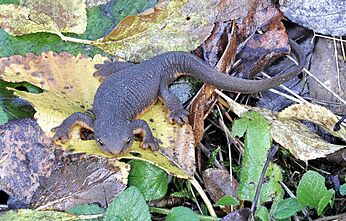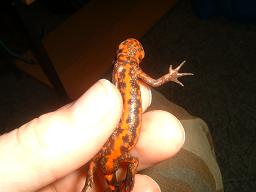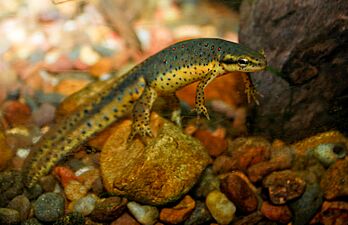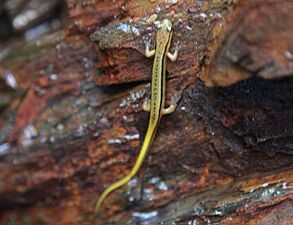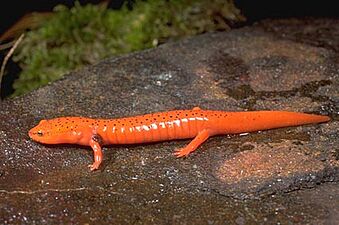Batrachochytrium salamandrivorans facts for kids
Quick facts for kids Batrachochytrium salamandrivorans |
|
|---|---|
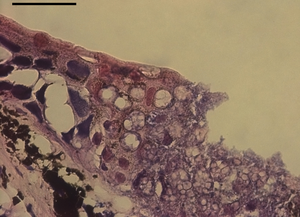 |
|
| Bsal infection in the skin of a fire salamander | |
| Scientific classification |
Batrachochytrium salamandrivorans (Bsal) is a tiny fungus that causes sickness in amphibians. It's a type of pathogen, which means it can cause disease. While salamanders and newts are most often affected, some frog species can also get sick. Bsal is a new problem. It is a big danger to salamanders in Europe and North America.
Scientists first described Bsal in 2013. They found it in the skin of fire salamanders (Salamandra salamandra). This fungus had already wiped out many fire salamander groups in the Netherlands. Scientists used special tests to confirm it was related to another well-known fungus called B. dendrobatidis. Like its relative, Bsal causes a disease called chytridiomycosis. This disease leads to skin sores and can kill salamanders. The fungus badly damages the skin. This can cause problems with how the salamander's body controls water. It can also lead to serious infections.
Another study suggests Bsal separated from B. dendrobatidis a very long time ago, during the Late Cretaceous or early Paleogene periods. Early tests showed that frogs and caecilians (worm-like amphibians) seemed to be safe from Bsal. However, it was deadly for many European and some North American salamanders. East Asian salamanders could get infected but often survived. The fungus was even found in a 150-year-old museum sample of a Japanese sword-tailed newt. This suggests Bsal first appeared and developed with salamanders in East Asia. This area is its natural reservoir, meaning it lives there without harming its hosts too much. It was likely brought to Europe more recently through the pet trade, possibly with animals like fire belly newts.
More studies support the idea that Bsal came from Asia. They found Bsal in wild urodela (salamanders and newts) in Asia. They also found it in Asian animals being moved for the pet trade. Since its discovery, Bsal has been found in more places across Europe. This includes both wild and pet salamander groups. One study found Bsal in 7 out of 11 pet urodele collections.
The discovery of this dangerous fungus worried scientists and the public. They feared it could be a major threat to salamanders in the Western world. To help stop the spread, the U.S. government banned the import of salamanders on January 12, 2016.
Contents
What's in a Name?
The name Batrachochytrium comes from Greek words. Batrachos means "frog," and chytra means "earthen pot." This describes the part of the fungus that holds its spores. Salamandrivorans comes from the Greek word salamandra (salamander) and the Latin word vorans (eating). This refers to how the fungus badly damages salamander skin and causes them to die quickly.
Where is Bsal Found?
Bsal naturally lives in a specific climate in East and Southeast Asia. In Europe, where it was introduced, it was first found in the Netherlands in 2012. There, it wiped out most of the country's small fire salamander population. Since then, it has spread naturally into Belgium, western Germany, and possibly Luxembourg. It might have been in some of these areas before outbreaks were officially reported. For example, the oldest known record is from Germany in 2004. In Germany, it's mostly found in North Rhine-Westphalia and Rhineland-Palatinate. The main area is in the Eifel Mountains, where it has caused many fire salamanders to disappear. In 2024, it was found in Hesse, near North Rhine-Westphalia. It caused many fire salamanders to die there.
There have also been a few separate outbreaks. One was in the Steigerwald in Bavaria, Germany. It might have arrived there on shoes, animals, or machines. It's also possible it spread naturally from northern Germany without being noticed. The most southern outbreak was found in Allgäu in 2020. This one might have come from infected water plants used for garden ponds. This outbreak caused many alpine newts to die. Because it's close to the Alps, this outbreak is a big risk to the alpine salamander and Lanza's alpine salamander if it spreads.
Another outbreak was found in one place in Catalonia, Spain, in 2018. This likely happened because pet salamanders were released there. This outbreak killed fire salamanders and marbled newts. It was a serious threat to the unique salamanders of the Iberian Peninsula. So, the area was closed off to stop the outbreak from spreading. Other reports of Bsal in Spain are thought to be mistakes. Later checks of those places found no sign of the disease.
Salamanders at Risk
The most complete study on which species get Bsal was done by Martel et al. in 2014. Their tests showed that many Salamandridae species (a family of salamanders and newts) were very likely to die from Bsal. Newer research shows that some salamanders without lungs, especially those in the Spelerpini group, might also get sick from Bsal.
Threats to Salamanders
Bsal is a serious danger to salamanders. It has not yet been confirmed in North America. But in Europe, Bsal has caused huge problems for some salamander groups. It is believed to have caused a 96% drop in salamander numbers in the Netherlands. More than one-third of the world's salamanders live in the United States. About 40% of these salamanders are already in danger. Both Canada and the United States have rules about importing amphibians. This helps reduce the risk of Bsal coming in through the pet trade. However, Mexico does not have strong rules. Bsal could potentially infect 80 to 140 different salamander species in North America.
Tolerant Species
These species can get Bsal but often survive:
Susceptible Species
These species can get sick from Bsal:
- Cynops cyanurus
- Cynops pyrrhogaster
- Paramesotriton deloustali
Lethal Species
These species often die from Bsal:
- Hydromantes strinatii
- Salamandrina perspicillata
- Salamandra salamandra
- Pleurodeles waltl
- Tylototriton wenxianensis
- Notophthalmus viridescens
- Taricha granulosa
- Euproctus platycephalus
- Lissotriton italicus
- Ichthyosaura alpestris
- Triturus cristatus
- Neurergus crocatus
- Eurycea wilderae
- Pseudotriton ruber




